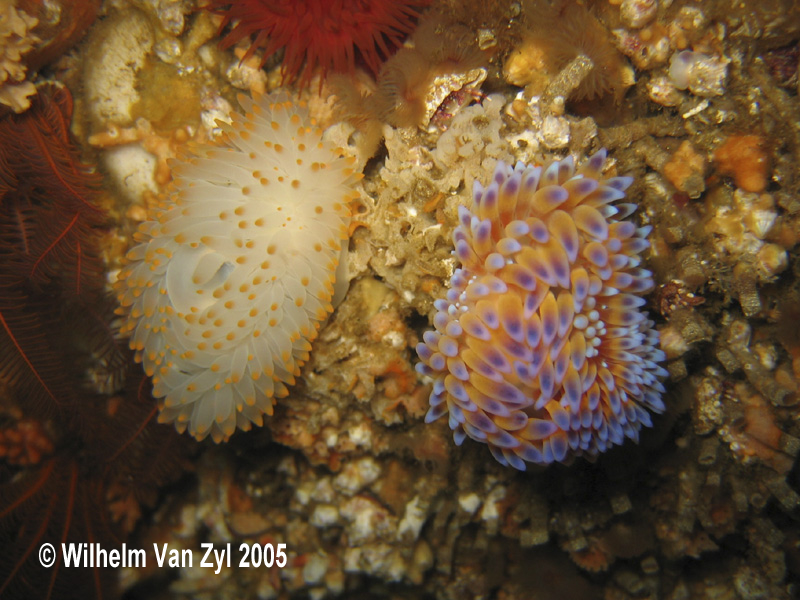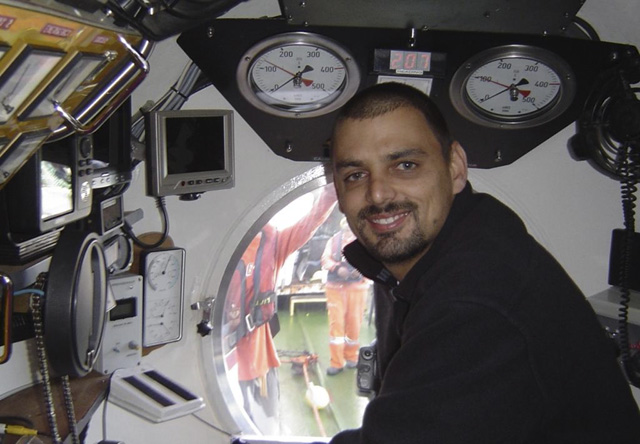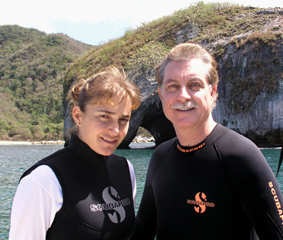 |
Bonisa nakaza
Photo courtesy of Wilhelm Van ZylFalsebay, South Africa
Bonisa nakaza Gosliner, 1981
Bonisa nakaza is truly one of the most beautiful of the members of the family Zephyrinidae, although one must admit, most of the members are gorgeous. The genus Bonisa was erected to differentiate B. nakaza from other species of Janolus. Species of Bonisa differ from Janolus in lacking branches of the digestive gland in their cerata. Bonisa is named in dedication of Terry Gosliner’s (the describer) wife, Bonnie.
Wilhelm’s photo above taken in Falsebay, South Africa actually shows both of the common color phases of this variable species . On the average the lower portion is yellow with blue towards the tip. Some have a subapical internal concentration of black or dark blue pigment. In other animals, as seen above, the blue pigment is absent from the cerata, which are translucent white with a yellow or orange tip.
Like other zephyrinid’s Bonisa has a prominent carnacle, a cock’s comb like organs between the rhinophores. Biologists ponder its function today. This would be a great student project.
In case you were wondering, as Valda Fraser was on Bill Rudman’s Forum, “nakaza” is a Zulu word meaning - to adorn with beautiful colors. Obviously Terry intended the name for the species bright coloration, and for that of Bonnie’s own beauty.
B. nakaza feeds on the heavily calcified bryozoan Tubucellaria levinseni and is found from the shallow waters to a depth of about 90 feet. It reaches a length of 10cm as an adult. This species is known from the Cape Peninsula to Port Elizabeth, South Africa; both Atlantic & Pacific coasts.
Danville, Calif
Jun. 2005
Wilhelm Van Zyl

My name is Wilhelm van Zyl; I am 29 years of age. I live in Cape Town, South Africa. I have been SCUBA diving since 1997, and have an advanced openwater certification and also a Class IV commercial qualification needed to do any underwater work in South Africa. I also enjoy other underwater sport namely freediving, spearfishing and underwater hockey (anything you can do with a mask and snorkel!). I studied BSc at the University of Port Elizabeth in the Eastern Cape. I majored in Zoology and Geology and went on to do my Honers degree in Geology. I am currently working as a geologist in the offshore diamond mining industry. (No diving involved). |
The camera I am using is a Cannon A80 with Cannon underwater housing. As I do not have an external strobe I am limmited to takeing macro shots. But as I really like nudibranchs this is not such a big problem.
Send Wilhelm email at diving@cyberdale.co.za
March 2005

Ali Hermosillo and Dave Behrens
Author:
Pacific Coast Nudibranchs
Send Dave mail at dave@seachallengers.com
|
